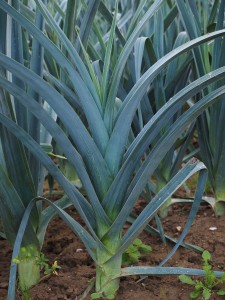Leek – Purjo
Allium porrum
Amaryllidaceae family
The leek is type of onion bulb that instead of being spherical is elongated and in the process of growing. The ´stem` of the leek is in fact a collection of tightly packed long leaves arranged concentrically around each other and finally emerging at the top of the plant as the familiar green leaves of a leek. The lower parts of the leaves are white and the color progressively changes to a pale then finally to a dark green. A good leek is considered to have a long ´stem` a large proportion of which should be white.
Growing high quality tall leeks requires a good well manured and fertilized loamy soil, it can take around 120 days until a leek a fully grown so starting early with 6-8 week old transplants is important. A traditional method has been to ´earth up` leeks, meaning that as the plant grows earth is built up around it covering the lower stem and causing it to remain white. Modern varieties have been selected to be naturally tall and white without needing this.
Nutritionally leeks have the fiber and many of the vitamins and minerals associated with a vegetable super food. They are slightly sweeter and less strongly flavored than normal onions.
At harvesting leeks should be dug and not pulled from the soil, pulling will bruise the stem due to the grip required. Choosing the correct variety can mean that leeks are able to be stored in cold and moist conditions for 2-3 months. Leeks should be stored in an upright position to avoid bending of the stem.
Quality problems in leeks include short, thin, or split stems often common in poorly grown crops, blemishes on the stem and leaves due to insect and fungal damage and wilted yellowing poorly stored stems. A problem harder to spot is bolting (growth of premature flower stalk) this occurs in some varieties more than others and means the normally leafy center of the stem is replaced with a growing flower stalk.


